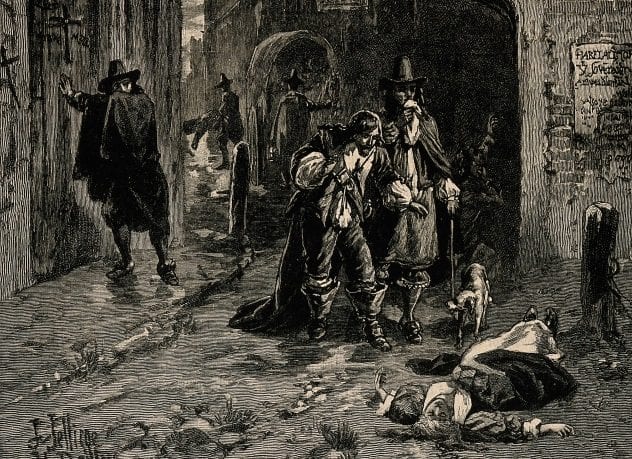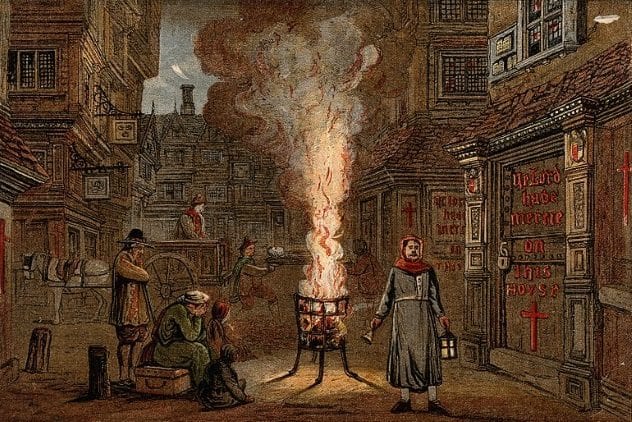 Animals
Animals  Animals
Animals  Weird Stuff
Weird Stuff 10 Weird Things People Used to Do at New Year’s
 Our World
Our World 10 Archaeological Discoveries of 2025 That Refined History
 Weird Stuff
Weird Stuff 10 Fascinating Facts You Might Not Know About Snow
 Miscellaneous
Miscellaneous Top 10 Things Crypto Was Supposed to Change & What Actually Did
 History
History 10 Huge Historical Events That Happened on Christmas Eve
 Music
Music 10 Surprising Origin Stories of Your Favorite Holiday Songs
 History
History 10 Less Than Jolly Events That Occurred on December 25
 Weird Stuff
Weird Stuff 10 Funny Ways That Researchers Overthink Christmas
 Politics
Politics 10 Political Scandals That Sent Crowds Into the Streets
 Animals
Animals 10 Species That Refused to Go Extinct
 Weird Stuff
Weird Stuff 10 Weird Things People Used to Do at New Year’s
 Our World
Our World 10 Archaeological Discoveries of 2025 That Refined History
Who's Behind Listverse?

Jamie Frater
Head Editor
Jamie founded Listverse due to an insatiable desire to share fascinating, obscure, and bizarre facts. He has been a guest speaker on numerous national radio and television stations and is a five time published author.
More About Us Weird Stuff
Weird Stuff 10 Fascinating Facts You Might Not Know About Snow
 Miscellaneous
Miscellaneous Top 10 Things Crypto Was Supposed to Change & What Actually Did
 History
History 10 Huge Historical Events That Happened on Christmas Eve
 Music
Music 10 Surprising Origin Stories of Your Favorite Holiday Songs
 History
History 10 Less Than Jolly Events That Occurred on December 25
 Weird Stuff
Weird Stuff 10 Funny Ways That Researchers Overthink Christmas
 Politics
Politics 10 Political Scandals That Sent Crowds Into the Streets
10 Horrors Of The Great Plague Of London
Called the last great plague of London, the Great Plague began in the spring of 1665 and ended roughly a year later. Officially, over 68,000 people died, but many believe that the number of plague deaths was closer to 100,000.
During this time, the people of London lived through one unimaginable horror after another. Families died, dead bodies were often dumped onto the streets until they were picked up by the buriers, and the smell of death was everywhere. It was Hell on Earth, and many people thought it would be the end of all times.
10 Hush-Hush

At the start of the plague, when the deaths started to noticeably increase, the outbreak was publicly minimized. This was due to the fact that England didn’t want trade overseas to be interrupted. If news of the plague reached other ports, English ships would be denied entry, and trade would come to a standstill.
However, the wealthier residents of London had a pretty good idea of what was going on, and they packed up and left for the country, hoping to outrun the deadly plague. Other residents simply ignored the early signs of the plague and continued to be as social as ever.
9 Not Allowed To Leave

While the wealthy inhabitants of London were able to get out at the start of the plague, the poor were not as fortunate. As the number of deaths continued to rise, many of those living in poverty didn’t want to risk losing their jobs or giving up their tiny flats. This was the only life they had, and there was nothing for them outside of London.
By the time the death count had reached hundreds per week, more and more of the poor decided to risk everything and leave London for the country. The only problem was that by this time (June 1665), the poor could no longer get approval to leave London.
Anyone who wanted to leave London had to get papers stating that they were free of the plague and were permitted to leave. The lord mayor stopped issuing these documents, and counterfeiters offered fake documents for a stiff fee. Once again, the poor were left to suffer.
8 Shut Up In Houses

One of the Plague Orders by the Privy Council stated that any house containing someone infected with the plague must be shut up. The whole family had to remain inside the house, sick or not, for a total of 40 days. A red cross was then painted onto the door to warn others that the occupants had the plague.
This was a controversial order because many felt that it was an automatic death sentence for family members who were still healthy. Nathaniel Hodges, a physician during the Great Plague, believed that the order increased the death toll, but he was powerless to oppose it. It was for the greater good that those with the plague and those exposed to it be removed from the general population.
There were accounts of entire families with small children being shut into their homes. Sometimes, the parents had to suffer through the deaths of their children. Other times, the parents died first, and neighbors watched through the windows as the children perished, one by one, either from the plague or starvation.
By September 1665, the quarantines could not be held. Too many people were sick and dying.
7 . . . Until They Had The Plague

In a quarantine that went horribly wrong, a family was shut into their home for 40 days because their maid servant had spots on her skin. She got better, but the family wasn’t allowed to leave their home until the quarantine was over and the family inspected. By then, the lady of the house had a fever from being shut indoors for so long, so the family had to undergo another 40-day quarantine.
During the second quarantine, more family members became sick. With no fresh air, no exercise, and being forced to stare at the scenery, it was no wonder that there were health issues.
The family was inspected again, found to be ill, and underwent yet another quarantine. This time, however, one of the people who inspected the home brought the dreaded plague in. Most of the family died.
6 Eyam

While people were being quarantined inside their homes in London, a shipment of dirty clothing was brought to the village of Eyam in Derbyshire. It was sent from London and carried the plague.
People began to get sick in Eyam, and the only way it could be contained was if they quarantined themselves. The village rector, William Mompesson, helped the people self-quarantine so that the plague would not be spread to the other villages. The rector’s wife and roughly 80 percent of the population inside the village succumbed to the plague.
5 Cats And Dogs Slaughtered

Not understanding that the plague was being spread by fleas found on infected rats, a rumor spread through London that it was caused by cats and dogs. Upon hearing this rumor, the lord mayor ordered all cats and dogs to be killed.
Little did he know that the cats and dogs helped keep the rat population down and that by ordering these predators killed off, he would enable the plague to spread more easily. It is estimated that over 200,000 cats and about 40,000 dogs were slaughtered.
4 Syphilis Was Thought To Prevent The Plague

The physicians of the mid-1600s practiced medical superstition. They strove desperately to understand the scientific medical world, but without the equipment we have today, these early doctors were destined to fail again and again.
During London’s last great plague, a rumor was recorded that syphilis was believed to give immunity to the plague, as though the one evil would cancel out the other. While there is zero truth to this old rumor, doctors did not dispute it. In fact, it appears as though many of them felt that the body was better able to “cast off” two sickness at a time, as opposed to being able to fight off just one deadly disease. In their thinking, the two “poisons” would battle each other and leave the body unharmed.
3 Fear The Plague Nurses

With so many people sick, plague nurses were hired by the city to take care of those in need. These women were illiterate and weren’t paid enough to sustain themselves on their own. They had to turn to other methods to produce a livable income, and as a result, both the sick and the healthy feared them.
The women would not only steal from the dead, but they would also help the dying on their way. The sooner a patient was deceased, the quicker the nurse could claim his personal belongings as her own. The nurses were also known to gather the sickness from the plague sores and use it to infect the healthy so that, upon death, they could take what they wanted.
2 People Threw Themselves Into The Pits

The churchyards could not handle all the dead, and pits were dug to dispose of the bodies. Men with carts would roam the streets, collecting the dead and disposing of them without any of the old funerary traditions being practiced.
People were not allowed to visit these pits for fear that they would spread the infection, but people who were already delirious with the plague were seen running toward them and throwing themselves in. In some cases, they would bury themselves in with the rest of the deceased.
1 An Unpleasant Death

Dying from bubonic plague was beyond unpleasant. It took several days for the victim to experience all or most of the symptoms.
First, there were headaches, fever, and vomiting. The patient might shiver uncontrollably. His tongue would swell up in his mouth, and the lymph nodes in his groin, armpits, or neck would also swell. If that wasn’t enough, the patient’s skin would get black blotches, hence the name “the Black Death.”
Elizabeth, a former Pennsylvania native, recently moved to the beautiful state of Massachusetts, where she is currently involved in researching early American history. She writes and travels in her spare time.








